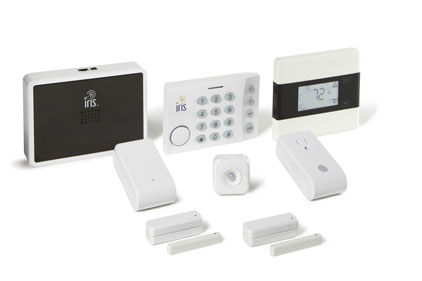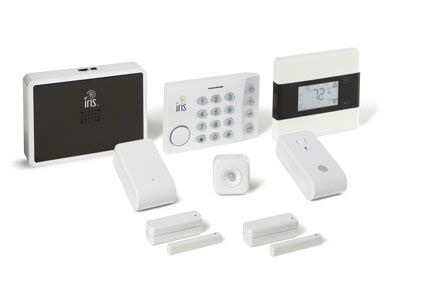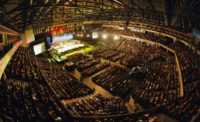 Just days ago (August 13), Lowe's Companies Inc., the second largest home improvement retailer in the world, had sales associates in 490 stores stock its version of a home automation system and accessories, Iris™, after a pilot that ran in 10 stores.
Just days ago (August 13), Lowe's Companies Inc., the second largest home improvement retailer in the world, had sales associates in 490 stores stock its version of a home automation system and accessories, Iris™, after a pilot that ran in 10 stores.
Iris allows homeowners to monitor and control their home from anywhere via smart phone, tablet or computer with a free basic level of service. Iris is currently available on Lowes.com
It’s squarely aimed at mass market, the “do-it-yourself lite” homeowner customers. While Kevin Meagher, Lowe's vice president of smart home in Mooresville, N.C., doesn’t believe his Iris products will jump off the shelves just yet (most shoppers will instead still head to paint, ladders and asphalt crack repair products at the home improvement stores), he does see the promise.
For the few systems already sold, mostly online, “customer reviews for Iris show buyers, by and large, are really pleased with the simple set up. And free basic service. And Iris can scale up, too,” Meagher says, suggesting that more home products ranging from thermostats to refrigerators and home healthcare devices will network in through his platform.
Bringing security and automation to the masses will take a long, long time, however.
Many home automation experts don’t expect to see the “home of the future” until, say, 2020. These tech analysts envision a future with “smart” devices and environments that make systems more efficient. But the early evidence is that the costs and necessary infrastructure changes to make it all work are daunting. And the experts note that people find comfort in the familiar, simple, “dumb” systems to which they are accustomed, according to Lee Rainie of Pew Research Center’s Internet & American Life Project.
That doesn’t turn off eager retailers.
Meagher and retailer colleagues such as Kris Bowring, senior director and platform lead for the home and energy management business at Best Buy of Richfield, Minn., are, for the long run, convinced that mass market is the sweet spot for home automation. “We are getting in before the utilities,” points out Meagher.
Not so much to sell their hubs, platforms, sensors and electric plugs but for other manufacturers’ networkable devices and appliances, the high volume, high margin items that will be made, possibly exclusively, to handle their platforms.
The mass marketing of home automation is a significant assignment.
According to Dennis Kyle, vice president, strategic and new markets at Tendril of Boulder, Colo., the Lowe’s entry is both “very positive and very negative. They dropped a bomb on the market before the market even gets started, though the more mass market [such companies focus on] the better.”
No doubt, many electronic home system contractors aren’t walking down Lowe’s aisles.
“It's another one of many cheap DIY home controls kits. The people who buy them are of little concern to my business. I wish them success with the kits,” says Rich Green of Rich Green Design, Palo Alto, Calif., a three-term CEDIA board member, a CEDIA Fellow and who chairs its technology council.
Still, cheap may prove a good thing. Obviously, the bad economy is going to delay overall home automation progress. Many current smart systems are not really affordable and people are focused on other things when it comes to change, according to the Pew Research Center’s Internet & American Life Project. One study respondent, Kevin Novak, a vice president with the American Institute of Architects and co-chair of the eGov Working Group of the World Wide Web Consortium, notes, “The technology and available systems will not be the impediment to adoption. The financial costs will be.”
Lowe’s Iris, coupled with recent cable and telecom offerings based on a monthly subscription, aims at opening up the middle for security, energy management and home automation, fitting in between the geeks buying gear off the Web and the mostly higher end homeowners going through design and install professionals.
“Say professionally installed home security penetration is 20 percent. We target the other 80 percent,” says Meagher. Concerning third party security monitoring, the Lowe’s executive characterizes it is a “small customer base paying a high fee for just one service” that’s mostly false alarms. There is even more growth potential in sophisticated home automation at the mass market level, he contends. “If this market takes off, the key to consumers is one user interface. [Device and appliance manufacturers] will look at the infrastructure we created and work with Iris,” Meagher suggests.
When it comes to door controls, Lowe’s already has a relationship with Schlage of Swords, Ireland, Ingersoll-Rand. But soon, Meagher hints, it will include manufactured-in sensor technology that allows doors from Therma-Tru of Maumee, Ohio, and sold by Lowe’s, for example, to connect into the Iris platform.
You can view it all as the silver among the darkening clouds. “It might make more people aware of energy management and home controls. This is good for our market because more people will seek professional help,” Green says. Rob Puric, director of residential intrusion systems at Honeywell Security Group of Louisville, Ky., agrees. “We do see companies building out awareness.”
Still, when it comes to home energy controls and management, Kyle believes that homeowner incentives are a concern. “It’s hard for them to get their arms around the savings. But energy helps you get to the mass market.”
There is a downside history to DIY attempts, says Puric. “Who do you call when things go wrong? What is the real level of technology? How about battery life for sensors?” Reviews of the Iris approach mirror that concern. Some buyers, who are somewhat satisfied with the product, are less so when contacting the company about questions of installation and operation. And there is some reported disappointment when it comes to window sensors where natural physical gaps create false alarms.
Storm clouds are forming above some professional electronic system contractors, however. Self-monitoring, with homeowners directly getting intrusion alerts or security video clips so they can determine and then take action including calling the police, is spreading as more people are equipped with smartphones, broadband and cloud computing on the Internet. Adjusting home HVAC and lighting or measuring a refrigerator’s electricity use seems more a homeowner’s task than a third party monitoring service or a utility’s job, with the thousands of regional utilities lagging and unprepared to serve what they consider ratepayers instead of clients.
“As it [mass market home automation] becomes more mainstream, custom will have less to do. There will be pressure on custom designers and installers,” Kyle says.
Security industry firms such as Alarm.com of Vienna. Va., with home services delivered through dealers, obviously see value in wireless, Web and mobile technologies, all built on a hosted services platform. And, according to Jay Kenny, vice president of marketing at Alarm.com, “Entry into the interactive home security and monitoring market by major retail brands, as well as national cable and telecom providers, highlights a growing opportunity. There is clearly increasing customer demand for interactive services with new features like video monitoring, energy management and home automation.”
So these types of Web-based platform businesses, which may have first started with a security focus, are branching out. Firms “that are able to deliver these services will be well positioned in the changing market,” says Kenny.
Since the Lowe’s model and some other mass market home automation services do not offer third party security monitoring, will self-monitoring marginalize the central station model?
Observes Kenny, “There is overall growth in the market and in the number of consumers interested in these services. [But] professional monitoring is a key differentiator of a security system and will continue to be a critical to a complete solution. Professional providers who can meet the new consumer demand for energy management, home automation and video monitoring while delivering professionally monitored security services will be well positioned.”
Then there are the tools homeowners possess or will get one day soon: smarter smartphones, tablets, laptops and, especially, applications downloaded free or inexpensively.
So what is Lowe’s peddling? The base cost is $179 for a security kit with an Iris hub, door sensors, motion sensors and a security keypad. It’s also $179 for an energy kit with an Iris hub, one wireless, energy consumption-monitoring wall outlet and a thermostat. A combined kit with everything from both starter kits costs $299.
Like eating at a sushi restaurant, the extra plates add up. For instance, a wireless video camera from Lowe’s costs $129, while each additional key fob and door sensor costs $19.99.
But for $9.99 a month, no contract required, homeowners can upgrade to what Lowe’s calls Iris Magic, It lets the buyer set sometimes complex rules such as to not allow an appliance to be turned on if no one is at home. “The basic services are free. If there is a burglar alarm, you get a text message. But with Magic, you can tailor the system for specific needs, identify a broader circle of friends to get in touch with if there is a text alert. You can write rules that program the house to behave in certain ways,” says Meagher.
In the face of a growing mass market in security and home automation, Green firmly believes that professionals need to “keep designing and installing such systems. Charging appropriate fees for design and installation is the challenge. The Lowe’s announcement sets the bar low, and at those prices the result will not be very good. The general public will have less appetite for paying professional fees to do the job right.”
On the technology side, the Lowe’s Iris Hub can handle ZigBee, Z-Wave and Wi-Fi.
When it comes to home energy management, Lowe’s has partnered with Genability of San Francisco, Calif., for example, to provide levels of control and management of individual appliances and total energy use. But according to Best Buy’s Bowring, “Connected is not in most consumers’ mindset for appliances, at least for today.” Still, with the Lowe’s Genability application and through some others, the key to success in the mass market rests on partnerships. For instance, Lowe’s executives recently visited Tendril this summer. The latter company, with connections to numerous influential utilities, has a Tendril Connect product which enables homeowners to significantly control and manage their energy use.
There is continuing evidence, identified by smartHOME and SDM, of talks and relationships among security manufacturers and services, home automation firms, software firms, retailers, appliance makers, cable and telecom companies. For example, Genability is a partner of Lowe’s but also has a relationship with Alarm.com.
So these types of Web-based platform businesses, which may have originated with a security focus, are branching out. Firms “such as Alarm.com that are able to deliver these services will be well positioned in the changing market,” contends Kenny.
Honeywell’s Puric comments that his company does sell into the professionally designed and installed security and home systems market; still “we also sell thermostats at Lowe’s, too. But our Tuxedo Touch, a touchscreen that functions as an integrated security system keypad, home controller, camera viewer and digital picture frame in one, as well as Lynx Touch, part of Honeywell’s family of self-contained wireless controls, can tie into our own thermostats.”
Kyle doesn’t know which model will win out. “Cost is being pressured downward and price resistant increases. Who will be the biggest winner in home energy management beyond the homeowner? Utilities, home systems installers, telecom/and cable firms, DIY or others? Who knows? But it is obvious that the homeowner will be energized to better manage their energy consumption.”
However, when it comes to mass market of home security and automation, Lowe’s may be a poor sister to the subscription-based cable and telecom offerings being rolled out. The latter firms’ position is, according to Green, “potentially huge for those big companies with millions of customers but inconsequential for small, professional custom integrators.” The winner? ”Any company that owns a ‘trusted monthly billing relationship’ with millions of customers. Those are the only winners,” Green says.
Online Only: As cable, telecom and other big brands with deep pockets flex their significant marketing and advertising muscle in local market rollouts across the country, read “Cable and Telco Providers Present Challenges, Opportunities For Security Dealers” for advice to dealers and integrators on how to best protect their existing customer base, position themselves to remain attractive to new customers, and even capitalize on opportunities created by these developments






